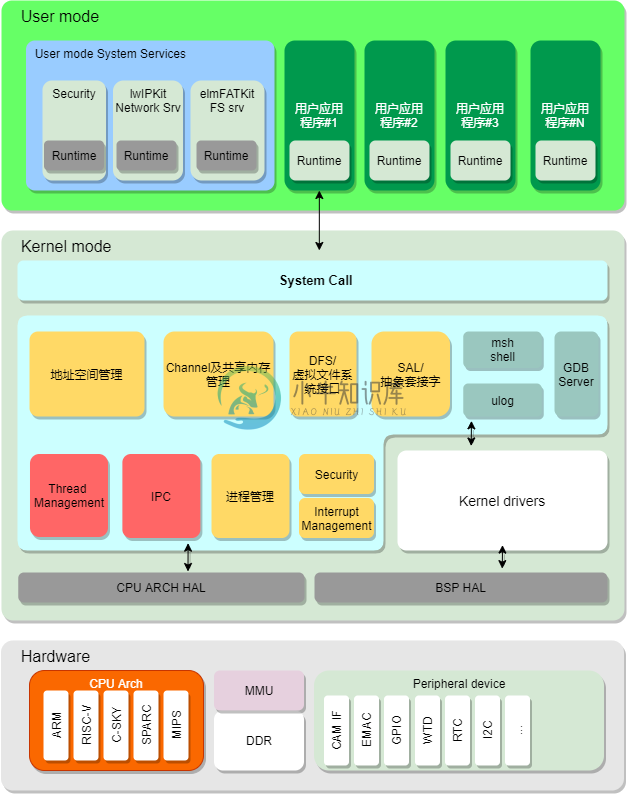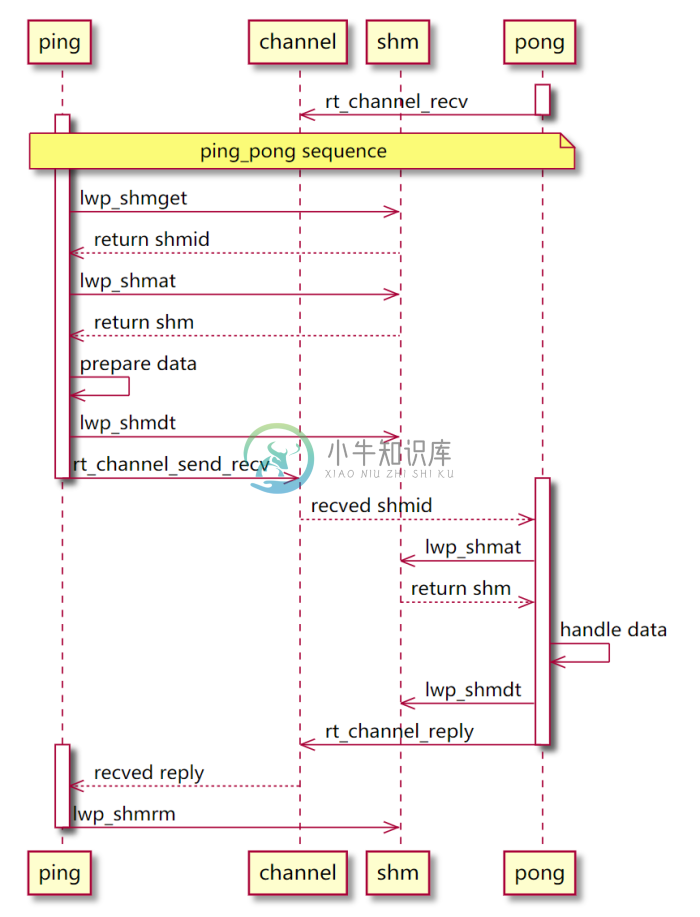架构说明
RT-Thread Smart 的架构
RT-Thread Smart 是基于 RT-Thread 操作系统上的混合操作系统,简称为 rt-smart,它把应用从内核中独立出来,形成独立的用户态应用程序,并具备独立的地址空间(32 位系统上是 4G 的独立地址空间)。
以下是 rt-smart 的整体结构框图,在硬件平台的基础上通过 MMU、系统调用的方式把整个系统分成了内核态及用户态。

RT-Thread Smart 的核心实现是 lwP,进程管理模块( rtthread-smart/kernel/components/lwp )。它包括了如下的几个部分:
- 面向用户态的系统调用(system call,
lwp_syscall.c/h); - 用户态进程管理(
lwp_pid.c/h, lwp.c/h); - elf 可执行应用程序加载器;
- 基于 MMU 的虚拟内存管理,地址空间管理;
- 进程间的 channel 通信机制及共享内存机制;
而在整体操作系统中,内核中还额外的包括了(原 RT-Thread 操作系统上的):
- 文件系统接口(DFS) - 虚拟文件系统接口;
- BSD socket 接口(SAL/socket) - 抽象套接字;
- 设备驱动框架接口;
- 可选的设备驱动(如 UART,GPIO,IIC 等);
用户态环境
用户态应用是一份 elf(Executable Linkable Format)文件,由 GNU GCC 编译链接而产生。在 RT-Thread Smart 中,它被固定加载到虚拟地址 0x100000 处执行。
一般来说,应用程序具备自己独立的 3G 地址空间,而高 1G 地址空间则留给了内核。对于一个 32 位芯片来说,典型的 RT-Thread Smart 应用程序及内核空间的内存分布如下图所示:

RT-Thread Smart 的用户态是固定地址方式运行,当需要系统服务时通过系统调用的方式陷入到内核中。用户态应用环境也存在对应的 API 环境:
- libc,rt-smart 选择的是 musl libc(在内核中目前也是 musl libc)。它提供了常规意义上的 POSIX 接口调用及 C 运行环境;
- 原 RT-Thread API 环境,也称为 RT-Thread CRT 环境。在这套 API 中,具备了原 RT-Thread 的 API 接口,例如 rt_thread_create,rt_malloc 等。一些原 RT-Thread 软件包,应用程序也非常方便的移植到 rt-smart 用户态环境中执行。同样的,因为 RT-Thread 内核中也存在一套 POSIX 环境,所以一些用户态应用也可以经过重新编译的方式,和内核编译在一起,从而在内核中执行。
基本的 IPC 客户端与服务端
IPC 服务(rtthread-smart/kernel/components/lwp/lwp_ipc.c/h)是实现用户应用程序和其他服务的桥梁,同时也可以是用户进程与用户进程之间的通信机制、内核与用户进程之间的通信机制。
在使用 IPC 服务时,需要先创建出对应的通道(channel),然后在通道上进行数据收发。一个 IPC 通道是一个双向数据传递的软件抽象,数据收发过程包括如下几种操作:
| 函数名 | 说明 |
|---|---|
| rt_channel_send | 向指定的 IPC channel 发送消息,当接收任务从 channel 中取走消息,并处理完毕后返回 |
| rt_channel_send_recv | 向指定的 IPC channel 发送消息,同时等待对端回复相应的消息 |
| rt_channel_notify | 向指定的 IPC channel 发送消息,并且不管后续情况直接返回 |
| rt_channel_recv | 从指定的 IPC channel 接收消息,直到接收到消息然后返回 |
以下是一份最基本的客户端与服务端,他们之间通过 IPC channel 的方式进行交互。先看 pong 服务端的代码情况,它实现的是一个消息接收,当收到消息数据时,再返回给客户端。
#include <stdio.h>
/* 使用 IPC 服务,需要包含 lwp.h 头文件 */
#include <lwp.h>
/* 包含 rtthread.h,可以使用原来的 RT-Thread API */
#include <rtthread.h>
int main(int argc, char **argv)
{
int i;
int channel;
char *str;
int shmid; /* 数据传输的共享内存块 ID */
struct rt_channel_msg msg_text;
/* 创建一个名字是 pong 的通道 */
channel = rt_channel_open("pong", O_CREAT);
if (channel == -1)
{
printf("Error: channel_open: fail to create the IPC channel for pong!\n");
return -1;
}
/* 输出等待的通道号 */
printf("\nPong: wait on the IPC channel: %d\n", channel);
/* 接收 100 次消息,然后退出 */
for (i = 0; i < 100; i++)
{
/* 从 pong 通道中接收消息,消息会放置在 msg_text 中 */
rt_channel_recv(channel, &msg_text);
/* 对应的共享内存 id */
shmid = (int)msg_text.u.d;
/* 通过共享内存 id,拿到对应的数据块 */
if (shmid < 0 || !(str = (char *)lwp_shmat(shmid, NULL)))
{
/* 接收错误,恢复错误信息 */
msg_text.u.d = (void *)-1;
printf("Pong: receive an invalid data.\n");
rt_channel_reply(channel, &msg_text);
continue;
}
/* 在终端上输出接收到的字符串 */
printf("Pong: receive %s\n", str);
/* 脱离数据块,代表本端不再使用这块数据 */
lwp_shmdt(str);
/* 准备回复信息 */
printf("Pong: reply count = %d\n", i);
msg_text.type = RT_CHANNEL_RAW;
msg_text.u.d = (void *)i;
/* 恢复给发送端 */
rt_channel_reply(channel, &msg_text);
}
/* 关闭这个通道 */
rt_channel_close(channel);
return 0;
}以下是 ping 客户端的代码,它会把一段字符串数据发送给 pong 进程。它会先准备这段字符串数据,然后从共享内存中创建出一块共享内存数据块,并把数据复制到共享内存数据块上,然后把共享内存数据 id 通过通道发送给 pong 进程:
#include <stdio.h>
#include <string.h>
/* 使用 IPC 服务,需要包含 lwp.h 头文件 */
#include <lwp.h>
#include <rtthread.h>
/*
* 因为需要把一段数据发送到接收端,而这段数据是在自己的进程空间中,所以
* 需要以共享内存的方式,把数据放到共享内存上,然后把对应的 id 发送到接收
* 端。这个过程中包括了开辟对应的共享内存页,复制数据,并返回对应的共享
* 内存 id。
*/
rt_inline int prepare_data(void *data, size_t len)
{
int shmid;
void *shm_vaddr;
/* 以当前的任务 ID 来做为共享内存标识的 key */
size_t key = (size_t) rt_thread_self();
/* 创建新的共享内存,并返回 id */
shmid = lwp_shmget(key, len, 1);
if (shmid == -1)
{
printf("Fail to allocate a shared memory!\n");
return -1;
}
/* 通过 id 获得共享内存数据块映射在本进程空间的地址 */
shm_vaddr = lwp_shmat(shmid, NULL);
if (shm_vaddr == RT_NULL)
{
printf("invalid address!\n");
lwp_shmrm(shmid);
return -1;
}
/* 把数据复制到共享内存上 */
memcpy(shm_vaddr, data, len);
/* 脱离共享内存,表示不再使用它了 */
lwp_shmdt(shm_vaddr);
return shmid;
}
int main(int argc, char **argv)
{
int i;
int channel;
/* 用于放置消息的字符串数组 */
char ping[256] = { 0 };
size_t len = 0;
/* 定义发送的消息结构体和收到回复的消息结构体 */
struct rt_channel_msg ch_msg, ch_msg_ret;
/* 打开名字是 pong 的数据通道 */
channel = rt_channel_open("pong", 0);
if (channel == -1)
{
printf("Error: could not find the pong channel!\n");
return -1;
}
/* 100 次的经过 IPC 通道发送 ping 消息 */
for (i = 0; i < 100; i++)
{
printf("\n");
/* 初始化通道上要发送的消息结构体 */
ch_msg.type = RT_CHANNEL_RAW;
snprintf(ping, 255, "count = %d", i);
len = strlen(ping) + 1;
ping[len] = '\0';
/* 复制数据到共享内存中,并返回共享内存数据块的 id */
int shmid = prepare_data(ping, len);
if (shmid < 0)
{
printf("Ping: fail to prepare the ping message.\n");
continue;
}
/* 把共享内存块 id 赋值到消息结构体上 */
ch_msg.u.d = (void *)shmid;
printf("Ping: send %s\n", ping);
/* 发送消息并等待回复 */
rt_channel_send_recv(channel, &ch_msg, &ch_msg_ret);
printf("Ping: receive the reply %d\n", (int) ch_msg_ret.u.d);
/* 删除对应的共享内存块 */
lwp_shmrm(shmid);
}
/* 关闭通道 */
rt_channel_close(channel);
return 0;
}整体的消息流图如下所示


